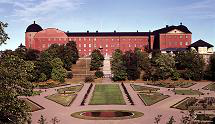Speaker
Dr
Konrad Piszczatowski
(Uppsala University)
Description
A nonadiabatic description of the hydrogen-antihydrogen scattering is presented. The collisions are treated within the Coupled Rearrangement Channels method, which allows us to include different possible arrangement channels of the system under consideration. More over the proper asymptotic form of the continuum wave function is ensured, while the inner part of the wave function can still be described with square-integrable basis functions, as in the bound states calculations. The description of the rearrangement region is done in terms of the solutions to the discretized 4-body problem; hence it does not suffer from the limitations of the Born-Oppenheimer approach.
Our method allows us to obtain a proper description of the 4-body system for any arrangement configuration and for any intermonomeric distance.The correct description of the asymptotic behavior of the total wave function is obtained by imposing proper boundary conditions on the functions describing the relative motion of the monomers at large separations. With these conditions the function describing the relative motion of the monomers is obtained by solving integro-differential equation, which automatically ensures a smooth transition between asymptotic and inner part of the total wave function.
The scattering matrix is obtained form the shape of the wave function in the asymptotic region and further the scattering length for the elastic hydrogen-antihydrogen collisions can be calculated. The value of the scattering length obtained in the present work is 7.27 bohr, which is significantly different from earlier values obtained within the Born-Oppenheimer approximation.
Primary author
Dr
Konrad Piszczatowski
(Uppsala University)
Co-authors
Dr
Alexei Voronin
(P.N. Lebedev Physical Institute)
Prof.
Piotr Froelich
(Uppsala University)
Mr
Stegeby Henrik
(Uppsala University)

